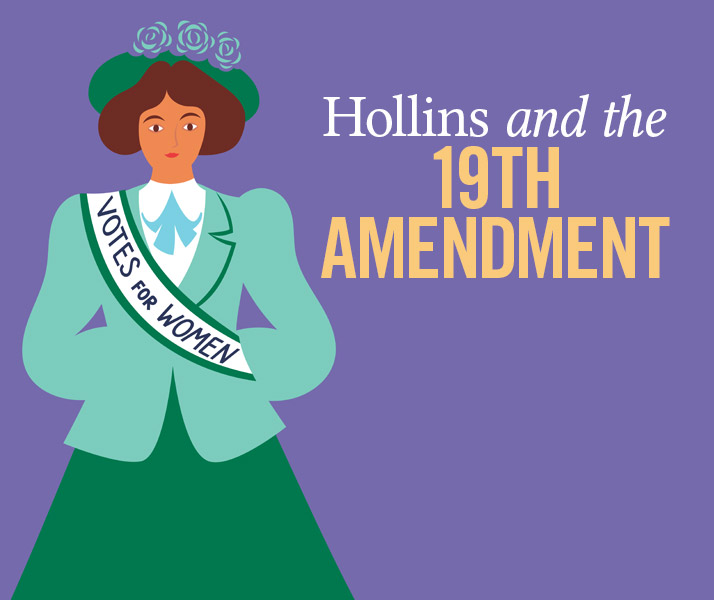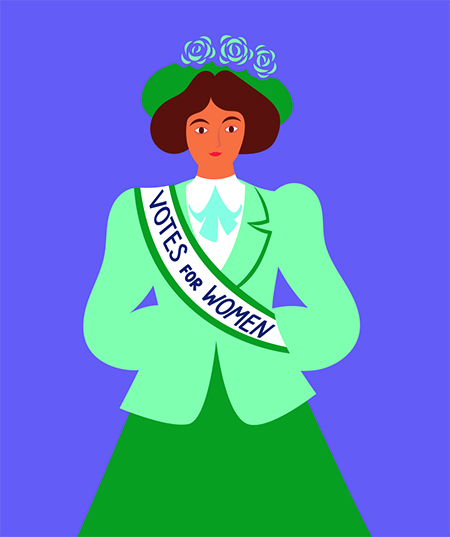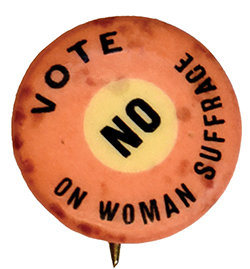
Hollins and the 19th Amendment
University archives contain clues to what students were thinking about women’s rights, including the right to vote, in the decades preceding the passage of the 19th amendment.
By Jean Holzinger M.A.L.S. ’11
 Looking back on her days at Hollins, Eudora Ramsay Richardson, class of 1909, remarked that her alma mater was always ahead of its time, “if not with the radicals, at least in the vanguard of the conservatives.”
Looking back on her days at Hollins, Eudora Ramsay Richardson, class of 1909, remarked that her alma mater was always ahead of its time, “if not with the radicals, at least in the vanguard of the conservatives.”
Richardson, who in 1936 wrote a book about women and public speaking (The Woman Speaker), and was active in women’s causes, had it about right in her assessment of her college and its students’ attitudes toward the 19th amendment. They were slow to embrace women’s suffrage, in part because Hollins discouraged any kind of political talk. The 1891-92 catalog, for example, includes this admonition:
But a boarding school for girls, of all places, is the most inappropriate arena for the discussion of party politics and sectarian tenets and distinctions. We discourage all such discussions.
And in 1895, a student dismissed the cause in an editorial in the Semi Annual:
Forgive us, gentle reader, if we evade a discussion of that intangible something, “The Woman Question.” We fear that in the inevitable future woman’s suffrage will come, but at present the movement is in its infancy—and perhaps this accounts for the fact that our junior philosophers have found its childish prattle wholly illogical.
By 1912, the mood had shifted, as Beth Harris, university special collections librarian and archivist, observed. One student noted (“Politics Viewed from the Hollins Angle” by J. B., Nov. 1912, Hollins Magazine) that “we are as yet too conservative to adopt the ‘Votes for Women’ cry at Hollins, but amongst most of the girls the subject of politics is discussed with enthusiasm.”
For a library exhibition she put together several years ago about Hollins and the 19th amendment, Harris found a variety of clues to the thinking on campus: among them, a speech given at Hollins in 1878 by Dr. J. J. Moorman, a Salem physician, about the “horrors of Women’s Rights” (reported in Hollins Magazine); and a reading at the 1882 commencement by a student, M. Lou Palmer, which posed this provocative question: “Is It True that There Is a Growing Danger of Women Losing Caste in America?”
 Minds began to open, gradually, in the early years of the new century. For example, an editorial in a 1910 issue of Hollins Magazine asked, “Is the Hollins Girl of To-day Ignorant of Contemporary Events?” And, according to Harris, after several prominent members of the Equal Suffrage League of Virginia visited campus in 1914, a student reported in Hollins Magazine that “not everyone at Hollins became a suffragist forthwith, but a surprising number of suffrage buttons were seen in the next day or two, and all who heard the able and earnest addresses realized that at least no woman of today has a right to be indifferent toward this much mooted question.”
Minds began to open, gradually, in the early years of the new century. For example, an editorial in a 1910 issue of Hollins Magazine asked, “Is the Hollins Girl of To-day Ignorant of Contemporary Events?” And, according to Harris, after several prominent members of the Equal Suffrage League of Virginia visited campus in 1914, a student reported in Hollins Magazine that “not everyone at Hollins became a suffragist forthwith, but a surprising number of suffrage buttons were seen in the next day or two, and all who heard the able and earnest addresses realized that at least no woman of today has a right to be indifferent toward this much mooted question.”
Students began exploring the pros and cons of women’s rights, including suffrage, in their works of fiction, too. The 1911 May Day celebration, for example, included a performance of a student-written play called My Wife Is a Suffragette! “Margaret Decides” (Hollins Magazine, 1914, by Judith Riddick) is a story about a young woman who argues with her boyfriend about her membership in the Woman Suffrage League before he goes off to war. By the time he returns, she has decided to quit the league, but he’s found someone else (more pliable?) to marry.
“We feel as though we had, to some degree, paved the way for our first real
voting at some time in the near future.”
Of course in 1920, the 19th amendment became law. Hollins students who were 21 that November could vote in the official elections. For those too young to vote, students held a mock election, with elaborate preparations leading up to the ballot. Frances Warren, class of 1923, wrote in Hollins Magazine (Dec. 1920):
Monday night the Republicans took the school entirely by surprise when they marched upon the campus in a torch light parade. … However, the Democrats were not to be outdone by their opponents, and so on Tuesday they came forth with an equally original and inspiring demonstration. … And now it is time for the most important action of the day—the casting of the votes. This was accomplished in a systematic way and a true political spirit, according to the rules and regulations of the polls.
The Democrat, James Cox, won the campus, if not the national, vote. All in all, wrote Warren, “We feel as though we had, to some degree, paved the way for our first real voting at some time in the near future.” In March 1921, Hollins Magazine reported that graduating seniors, “many of whom were able to vote the first time, were addressed at commencement as ‘fellow citizens’ on a subject in keeping with their new privilege and position.”
